Life with the Bogans, Hoons and Larrikins
POSTED ON 27/02/2010At my father-in-law's 60th birthday party last week, we all did our bit for Australia's ongoing wine glut. After Coopers Clear ale, bubbles and whites, the centrepiece of the impressive barbecue was the six magnums of 2000 Evans & Tate Lionel's Vineyard Cabernet Merlot Robert had laid down for the occasion: delicious, mature, claret-like elegance and textured silk with savoury bite. My wife's cousin Lesley was off to a bogan party immediately after. A bogan, says I? A bogan is a slob ( think Wayne and Waynetta) so a bogan party is an anti-fancy dress party where you dress down rather than up.
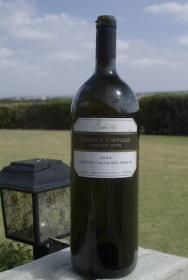 2000 Evans & Tate Lionel's Vineyard Cabernet Merlot
2000 Evans & Tate Lionel's Vineyard Cabernet Merlot
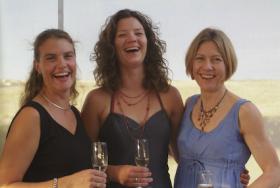 Vanessa, Lesley, Charmaine
Vanessa, Lesley, Charmaine
Mopping up the Aussie wine glut is hard work and after a hair of the dog day, we did the four hour drive through Bordertown to Horsham, Victoria, to visit Charmaine's sister and partner, Vanessa and Steve, on their horse farm. In Horsham, teens ritually drive too fast up and take roundabouts too noisily. This is known as hoon behaviour, and because of the many road accidents caused by young people, one of the punishments now meted out to hoons is to have your car crushed.
Bogans, hoons and let's not forget larrikins (the mischievous Aussie characters invoked recently by Oz Clarke bemoaning the absence of the old Aussie spirit) are as colourful a part of Australia's language as their names for places. On my father-in-law's actual birthday on Wednesday for instance, we took a family day out as wine tourists from the Grampians to the Pyrenees and back. The two regions are part of Victoria's 'mountain' wine country, bearing in mind that a mountain in Australia may not be all that it's cracked up to be ( a view the Aussies may now wish to dispute having won to gold medals in Vancouver). In the case of the Grampians, these definitely are mountains, craggy outcrops of rock rising out of the meadow and grain lands around rural Horsham quite spectacularly.
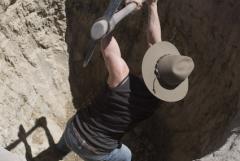 Charmaine digging a hole for herself on the farm
Charmaine digging a hole for herself on the farm
Driving east from Horsham towards Ballarat, you pass Mediterranean-like olive groves planted into the foothills and then on past a long, low stretch of the Grampians resembling an elongated Table Mountain. An hour or so to the east, the Pyrenees are, in contrast ,a series of undulating and steeper tree-clad hills, pretty grain and grazing country punctuated by small hamlets and farms, with a series of amphitheatres in which vines seem to thrive. Among the many small towns you drive through (Avoca and Moonambel are at the heart of the Pyrenees) there's even a small town called Amphitheatre.
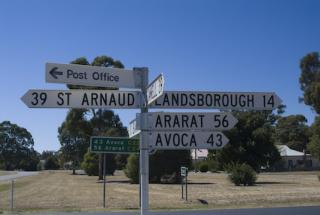 on the road
on the road
It was a beautiful sunny morning when we set out from Horsham and it stayed that way all day, a gentle cooling breeze being enough to make our drive and subsequent winery visits a delight. I wasn't too happy to lose my polarising filter which fell onto the road and cracked after I'd taken my first picture but the light was so clear and the sky so blue that my camera barely seemed to notice it. After stopping for the obligatory ice creams, we drove on towards Moonambel and immediately came across Taltarni and Dalwhinnie right next to each other.
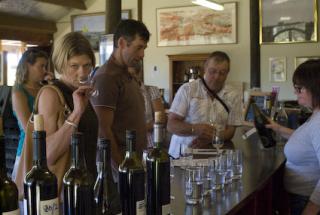 at Taltarni
at Taltarni
We didn't have a plan but it seemed too good to miss them, so we stopped first at Taltarni where we tasted our way through a substantial range of wines that included their Lalla Gully range from Tasmania. It's a pretty cellar door, with a terrace sloping down to a well-kept garden and trees beyond and in the distance the steep, dark green wooded hills of the Pyrenees. Taltarni's fizz is good, the 2008 Brut Taché pink fizz being the most refreshingly berry-fruity and even champagne-like of the range. I also liked the 2006 Sangiovese with its sour cherry fruit, but the most impressive red was the 2005 Heathcote Shiraz, with its spice, black cherry and elegant texture.
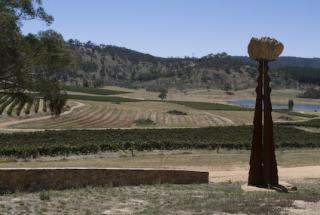 Dalwhinne
Dalwhinne
We arrived next door at Dalwhinnie to find a group of pickers picnicking under the shade of a eucalyptus tree in the great amphitheatre in which Dalwhinnie has a series of vineyard blocks and water catchment dams. It was the first day of harvest and according to the woman at the elevated boardwalk Cellar Door overlooking the vineyards (who I think may have been the wife of the owner, but I wasn't there as a journalist, so no third degree from me), it was the earliest they had picked in 30 years 'probably because of global warming'. She told us that all the vineyards on their alluvial clay quartz gravel soil were dry grown and , apart from a few hot days, the vintage hadn't been as hot this year as last.
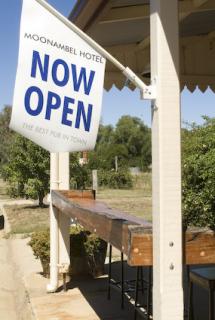 Moonambel
Moonambel
We started the tasting and as they had done at Taltarni, she produced glasses of water, unprompted for the six of us, a nice touch I thought. On the minus side, both here and at Taltarni, some of the bottles had been opened for more than a day and although kept in the fridge, I thought they just lacked that edge of freshness they might otherwise have had. To be fair, when I asked about the 2006 Dalwhinnie Cabernet, she did offer to open a fresh bottle. Very good wines here, a super-elegant and intense, burgundian 2007 Chardonnay, a fine raspberryish 2007 Shiraz tinged with vanillin oak and a distinctly cool climate 2006 Cabernet, its blackcurrant fruit underscored by cool climate capsicum elements.
Although this is the height of summer, there are hardly any tourists around. We seemed to be following the same two friendly couples to the same wineries, until they stopped off for lunch and we then found them following us. It's part of the charm of region like the Pyrenees. No crowded cellar doors or roads packed with holidaymakers, but rather a quiet, natural, rural setting for vineyards. I was even happy to find that there's very little in the way of restaurants in the Pyrenees (the only one recommended by the locals, the restaurant at Redbank, was a bit too far and none of us particularly fancied a cold meat ploughman's lunch).
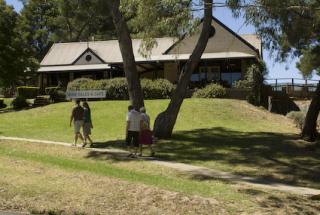 At Blue Pyrenees
At Blue Pyrenees
We stopped at the Moonambel Hotel for a pub lunch which exceeded expectations. A haddock-like fish (flake) and chips washed down with a Coopers Ale sitting out on the shaded terrace at the back was as good as it gets. Excellent grub for a small town pub, the good old Moonambel Hotel came up trumps, and it was only a short hop from there to the quaint old gold mine town of Avoca, where we seemed to be the only people in town sitting out on the pavement drinking our after-lunch coffees with a macadamia slice.
Finally on 7k from there to the Blue Pyrenees Winery, another pretty Cellar Door set in woodland, and a range in which my favourites were the 2001 Brut Rosé Pinot, the 2002 Midnight Cuvée Chardonnay, and the floral, apricoty 2009 Viognier. The reds were a bit too eucalyptusy for my taste (the woman serving us at the cellar door said that 'eucalyptus is a regional characteristic in all our reds'). From Blue Pryenees (it started out life as Chateau Remy) we ambled home through Ararat past Seppelt Great Western's cellars, formerly known as Seppelt Great Western Champagne Cellars. A delightful 400k round trip through some of the prettiest countryside imaginable and back to Horsham. After ice creams, lunch, cakes and coffee, I can't say that we really needed that meal at the Exchange Hotel in Horsham, but we did rather enjoy it.

